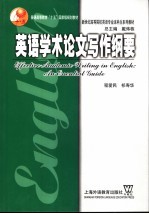

英语学术论文写作纲要PDF电子书下载
- 电子书积分:11 积分如何计算积分?
- 作 者:程爱民,祁寿华编著
- 出 版 社:上海:上海外语教育出版社
- 出版年份:2005
- ISBN:7810956817
- 页数:263 页
PART Ⅰ GENERAL FEATURES OF ACADEMIC WRITING 3
Chapter 1 Academic Writing:An Introduction 3
1.1 Academic Writing:A Definition 3
1.2 Characteristics of Good Academic Writing 5
1.2a Good Writing Calls for Critical Reading and Critical Thinking 6
1.2b Good Writing Involves Thoughtful Revision 7
1.2c Good Writing Is Directed Toward an Audience 8
1.2d Good Writing Achieves a Clear Purpose 9
1.2e Good Writing Expresses Ideas Clearly 9
1.2f Good Writing Pulses with Creativity 10
Chapter 2 Kinds of Academic Writing 12
2.1 Writing to Summarize 12
2.2 Writing to Synthesize 16
2.3 Writing to Explain 19
2.3a Writing to Inform 21
2.3b Writing to Explain Processes 23
2.3c Writing to Explain Concepts 25
2.4 Writing to Argue 28
2.4a The Logical Appeal 29
2.4b The Emotional Appeal 30
2.4c The Ethical Appeal 30
2.4d Five Basic Components 31
2.5 Writing to Propose 34
2.6 Writing to Analyze 36
2.7 Writing to Evaluate 38
Chapter 3 The Rhetorical Context and Characteristics of Academic Writing 42
3.1 The Rhetorical Context 43
3.1a Topic or Subject 43
3.1b Audience 44
3.1c Purpose and Role 48
3.2 Characteristics of Academic Papers 49
4.1 Process of Writing 55
Chapter 4 Finding a Topic 55
PART Ⅱ PROCESS OF EFFECTIVE ACADEMIC WRITING 55
4.2 Assessing Your Prior Interest and Knowledge 57
4.3 Narrowing the Topic—Creating a Good Title 59
4.4 Techniques for Inventing 61
4.4a Freewriting 62
4.4b Brainstorming 63
4.4c Branching 64
4.4d Cubing 64
4.4e Questioning or Journalistic Formula 66
4.5 Generating New Ideas by Critical Reading 67
Chapter 5 Researching the Topic 69
5.1 Field Research 70
5.1a Observing 71
5.1b Interviewing 73
5.1c Using Questionnaire 75
5.2a Library Sources and Materials 80
5.2 Library Research 80
5.2b Taking Notes 88
5.3 Internet Research 89
5.4 Keeping Track of Your Research 92
5.5 A Six-Step Approach to Research 94
Chapter 6 Outlining 98
6.1 The Structure of a Paper 98
6.2 Sorting Out Your Notes and Other Materials 101
6.3 Outlining 101
6.3a Draft Outline 102
6.3b Formal Outline 103
6.3c Two Commonly Used Patterns of Formal Outlines 105
6.4 Formulating the Thesis Statement 108
Chapter 7 Drafting,Revising,Editing and Proofreading 111
7.1 Drafting 111
7.2 Revising 114
7.2a Revising for Content and Organization—Macro-revision 115
7.2b Revising for Details—Micro-revision 116
7.3 Final Editing and Proofreading 122
PART Ⅲ STRATEGIES FOR EFFECTIVE ACADEMIC WRITING 127
Chapter 8 Organizing the Paper 127
8.1 Five Basic Organizational Patterns 129
8.1a General-to-Specific/Abstract-to-Concrete 129
8.1b Specific-to-General/Concrete-to-Abstract 132
8.1c Order of Importance 134
8.1d Chronological Order 135
8.1e Spatial Order 136
8.1f Other Organizational Patterns 138
8.2 Introduction 139
8.2a Narrative 140
8.2b Descriptive 141
8.2c Preparatory 143
8.2d Corrective 145
8.2e Inquisitive 146
8.2f Stating a Problem 147
8.2g Giving a Surprising Fact or Statistics 148
8.2h Using a Striking Quote 150
8.3 Conclusion 150
8.3a Restating the Main Points 151
8.3b Referring Back to the Thesis(and the Introduction) 151
8.3c Suggesting a Solution,Further Study,or Predicting an Out-come 152
8.3d Giving a Humorous Comment or Unexpected Twist 152
8.3e Using a Striking or Memorable Quote 153
Chapter 9 Strategies for Development 155
9.1 Definition 156
9.1a Sentence Definition 157
9.1b Extended Definition 158
9.1c Historical Definition 158
9.1d Stipulative Definition 159
9.2 Classification 160
9.2a Choosing the Principle(s)to Classify 161
9.2b Testing the Effectiveness 162
9.2c Explaining Each Subgroup 164
9.3 Example 166
9.3a Relevant Examples 167
9.3b Specific Examples 168
9.3c Sufficient Examples 169
9.4 Comparison and Contrast 170
9.4a Points for Comparing and Contrasting 170
9.4b Two Ways for Organizing Comparison and Contrast 172
9.4c Transitional Words and Phrases 175
9.5 Cause and Effect 176
9.5a Distinguishing Between Cause and Effect 176
9.5b Necessity,Sufficiency,and Mill's Methods 179
9.5c Organizing Cause and Effect Analysis 181
9.6 Generalization 186
9.5d Transitional Words and Phrases for Cause-and-Effect Analysis 186
9.7 Visual Elements 187
Chapter 10 Use of Sources and Documentation 189
10.1 Importance of Using and Documenting Sources 189
10.2 Three Ways to Use Sources 190
10.3 Styles of Documentation 193
10.4 MLA Style 194
10.4a In-text Citation 194
10.4c List of Works Cited 196
10.4b Explanatory Notes 196
10.5 APA Style 202
10.5a In-text Citation 203
10.5b Explanatory Notes 204
10.5c List of References or Bibliography 204
10.6 中文参考文献格式 210
Appendix:Sample Student Acaademic Writings 211
Works Cited and Consulted 263
- 《看漫画学钢琴 技巧 3》高宁译;(日)川崎美雪 2019
- 《现代水泥技术发展与应用论文集》天津水泥工业设计研究院有限公司编 2019
- 《“十三五”规划教材 中药鉴定学实验 供中药学 药学及相关专业使用 第2版》吴啟南 2018
- 《绿色过程工程与清洁生产技术 张懿院士论文集精选 上》《绿色过程工程与清洁生产技术》编写组编 2019
- 《复旦大学新闻学院教授学术丛书 新闻实务随想录》刘海贵 2019
- 《晚清民国船山学的接受与传播》吴戬著 2019
- 《清代宋词学研究》曹明升著 2019
- 《俞士镇学术文存 下》俞士镇著;俞元江,俞元淮整理 2019
- 《中国经典文化走向世界丛书 学术卷 2》龚海燕译 2019
- 《跟孩子一起看图学英文》张紫颖著 2019
- 《市政工程基础》杨岚编著 2009
- 《家畜百宝 猪、牛、羊、鸡的综合利用》山西省商业厅组织技术处编著 1959
- 《《道德经》200句》崇贤书院编著 2018
- 《高级英语阅读与听说教程》刘秀梅编著 2019
- 《计算机网络与通信基础》谢雨飞,田启川编著 2019
- 《看图自学吉他弹唱教程》陈飞编著 2019
- 《法语词汇认知联想记忆法》刘莲编著 2020
- 《培智学校义务教育实验教科书教师教学用书 生活适应 二年级 上》人民教育出版社,课程教材研究所,特殊教育课程教材研究中心编著 2019
- 《国家社科基金项目申报规范 技巧与案例 第3版 2020》文传浩,夏宇编著 2019
- 《流体力学》张扬军,彭杰,诸葛伟林编著 2019
- 《培智学校义务教育实验教科书教师教学用书 生活适应 二年级 上》人民教育出版社,课程教材研究所,特殊教育课程教材研究中心编著 2019
- 《习近平总书记教育重要论述讲义》本书编写组 2020
- 《办好人民满意的教育 全国教育满意度调查报告》(中国)中国教育科学研究院 2019
- 《教育学考研应试宝典》徐影主编 2019
- 《语文教育教学实践探索》陈德收 2018
- 《家庭音乐素养教育》刘畅 2018
- 《学前教育学》王换成主编 2019
- 《近代体育游戏教育史料汇编 第1辑 1》王强主编 2016
- 《全国学前教育专业(新课程标准)“十三五”规划教材 简谱手风琴教程 第2版》(中国)杨克勤,王宝庆 2019
- 《现代教育技术》李志河主编 2019
